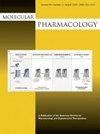药物与人类肝脏脂肪酸结合蛋白 (FABP1) 形成三元复合物,FABP1 结合改变药物代谢
IF 3.2
3区 医学
Q2 PHARMACOLOGY & PHARMACY
引用次数: 0
摘要
肝脏脂肪酸结合蛋白(FABP1)可与多种内源性脂质结合,并在人类肝脏中高度表达。与 FABP1 结合会改变肝脏中内源性脂质的代谢和平衡。药物也被证明能与大鼠 FABP1 结合,但人类 FABP1(hFABP1)的数据有限。FABP1 有一个很大的结合口袋,最多可有两种脂肪酸同时与 FABP1 结合。我们假设药物与 hFABP1 结合会形成三元复合物,而 FABP1 结合会改变药物代谢。为了验证这些假设,我们使用了原生蛋白质谱(MS)和荧光 11-(丹酰氨基)十一烷酸(DAUDA)置换试验来鉴定药物与 hFABP1 的结合,并研究了细胞色素 P450 2C9 (CYP2C9)在有 hFABP1 和没有 hFABP1 的情况下氧化双氯芬酸的情况。DAUDA 与 hFABP1 的结合涉及高亲和力(Kd,1=0.2 µM)和低亲和力(Kd,2 >10 µM)结合位点。九种药物与 hFABP1 结合,Kd 值从 1 微米到 20 微米不等。没有一种受试药物能完全将 DAUDA 从 hFABP1 中移除,荧光光谱显示有证据表明形成了三元复合物。本机质谱验证了 DAUDA-hFABP1- 双氯芬酸三元复合物的形成。Docking 预测双氯芬酸在 FABP1 的门区与 DAUDA 在结合腔内结合。在 FABP1 存在的情况下,CYP2C9 对双氯芬酸羟化的 kcat 降低了约 50%(p<0.01)。这些结果表明,药物会与 hFABP1 形成三元复合物,而 hFABP1 在肝脏中的结合会改变药物的代谢和清除。本文章由计算机程序翻译,如有差异,请以英文原文为准。
Drugs Form Ternary Complexes with Human Liver Fatty Acid Binding Protein (FABP1) and FABP1 Binding Alters Drug Metabolism
Liver fatty acid binding protein (FABP1) binds diverse endogenous lipids and is highly expressed in the human liver. Binding to FABP1 alters the metabolism and homeostasis of endogenous lipids in the liver. Drugs have also been shown to bind to rat FABP1, but limited data is available for human FABP1 (hFABP1). FABP1 has a large binding pocket and up to two fatty acids can bind to FABP1 simultaneously. We hypothesized that drug binding to hFABP1 results in formation of ternary complexes and that FABP1 binding alters drug metabolism. To test these hypotheses, native protein mass spectrometry (MS) and fluorescent 11-(dansylamino)undecanoic acid (DAUDA) displacement assays were used to characterize drug binding to hFABP1, and diclofenac oxidation by cytochrome P450 2C9 (CYP2C9) was studied in the presence and absence of hFABP1. DAUDA binding to hFABP1 involved high (Kd,1=0.2 µM) and low affinity (Kd,2 >10 µM) binding sites. Nine drugs bound to hFABP1 with Kd values ranging from 1 to 20 µM. None of the tested drugs completely displaced DAUDA from hFABP1 and fluorescence spectra showed evidence of ternary complex formation. Formation of DAUDA-hFABP1-diclofenac ternary complex was verified with native MS. Docking predicted diclofenac binding in the portal region of FABP1 with DAUDA in the binding cavity. The kcat of diclofenac hydroxylation by CYP2C9 was decreased by ~50% (p<0.01) in the presence of FABP1. Together, these results suggest that drugs form ternary complexes with hFABP1 and that hFABP1 binding in the liver will alter drug metabolism and clearance.
求助全文
通过发布文献求助,成功后即可免费获取论文全文。
去求助
来源期刊

Molecular Pharmacology
医学-药学
CiteScore
7.20
自引率
2.80%
发文量
50
审稿时长
3-6 weeks
期刊介绍:
Molecular Pharmacology publishes findings derived from the application of innovative structural biology, biochemistry, biophysics, physiology, genetics, and molecular biology to basic pharmacological problems that provide mechanistic insights that are broadly important for the fields of pharmacology and toxicology. Relevant topics include:
Molecular Signaling / Mechanism of Drug Action
Chemical Biology / Drug Discovery
Structure of Drug-Receptor Complex
Systems Analysis of Drug Action
Drug Transport / Metabolism
 求助内容:
求助内容: 应助结果提醒方式:
应助结果提醒方式:


